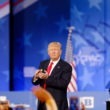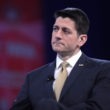Jim Jordan has been the Republican representative from Ohio’s 4th District for 11 years, so when he held a town hall meeting last February, it shouldn’t have been big news. But Jordan is an original founder of the Freedom Caucus, and unlike many of his colleagues now avoiding town hall meetings or hiring companies to recruit friendly audiences, Jordan didn’t attempt to close his meeting to his progressive critics. So when the congressman took heat from constituents on health care, abortion, gun safety, and Trump’s ties with Russia, the press got a story.
Jordan took it all in stride, telling reporters that democracy requires him to take questions from his harshest critics. While Jordan should get credit for not ducking his detractors, he can well afford to be magnanimous: in 2001, the 4th District’s lines were drawn so no Democrat could mount a real challenge, and after the 2010 census, Jordan’s district was gerrymandered again to further disenfranchise Democratic voters. From this bastion, Jordan is a force unto himself, able to ignore House Republican leaders and Donald Trump alike to join with his fellow Freedom Caucus members in pursuit of their agenda to remake America.
Jordan typifies what many believe is the profile of those 30-odd members of the Freedom Caucus: strident in their agenda, safely protected in unassailable election districts, and backed by lots of money and powerful interests.
The reality is more complicated—examining the fundraising records of the 2016 Freedom Caucus members, you’ll find that, with the exception of Ron DeSantis of Florida, they are underperformers. They spent an average of $894,550 per seat, or about half the $1.73 million average spent by Republican House incumbents overall.
Also, the simple truth is that all Republicans have benefited from two decades of state legislatures gerrymandering Congressional districts. Packing Democrats into districts in or near urban centers ensured that the 2016 Democratic class had an average winning margin of 41.5 points. The current class of Republican incumbents, meanwhile, averaged more than 60 percent of the total vote and a winning margin of 33.5. Isolate the Freedom Caucus members, and those percentages were just slightly lower—so the average Caucus member is no more secure than the average Republican in the House. Thus, based solely on election numbers, almost every House Republican could give Trump and Ryan a middle finger whenever they wanted.
Freedom Caucus members are also all white and, with one past exception, all male. But the real power of the Freedom Caucus comes from the group’s unique operation, and this it owes to two events—first, the rise of Newt Gingrich to House Speaker in 1995; and second, the Supreme Court’s Citizens United decision that expanded the power of undisclosed money and conservative organizations.
Let’s start with how Citizens United is a key to the origin story of the Freedom Caucus.
While the official founding of the Freedom Caucus dates to January 2015, its true origins are found in the suburbs of Richmond, Va., during the summer of 2014. Eric Cantor represented Virginia’s 7th Congressional District and was both the House Republican Majority Leader and Speaker John Boehner’s designated heir-apparent.
Cantor spent most of that spring raising money to boost Republican candidates around the country for the upcoming 2014 midterms, largely ignoring his own approaching Virginia primary. His opponent, David Brat, was an economics instructor at Randolph-Macon College, a small liberal arts school near Richmond. Brat, a devotee of Austrian economist Friedrich Hayek, theologian John Calvin, and, of course, Ayn Rand, announced his challenge through the National Review and conservative outlets like Breitbart in order to hook up with a national conservative network.
No one took Brat too seriously, given Cantor’s position and his $6 million campaign fund.
But Brat, a Virginia Tea Party organizer, gambled he could beat Cantor’s money with his strong ties to conservative organizations like the Koch brothers’ Americans for Prosperity, and by actively working conservative media. Brat used the same strategy that Ted Cruz employed when he scored his big 2012 upset in the Texas Senate primary. North Carolina might also have been an inspiration if not a model for Brat: for over a decade, billionaire Art Pope, working with conservative activists (see Washington Spectator, April 2014) had created organizations to push moderate Republicans out of the Tar Heel state legislature.
It worked: Cantor had no idea he was in trouble until a month before the primary, when “Brat packers” took over the Virginia Republican Convention, replacing the leadership with Tea Party loyalists, and booing Cantor off the stage. By then it was too late.With just over 36,000 primary votes, Brat beat Cantor and his millions by a whopping 11 points. In fact, Brat’s overall spending for all of election year 2014 was less than $1.5 million, because he relied heavily on third-party conservative groups. With the examples of North Carolina, Cruz, and Brat’s race on the books, the handful of House Republicans chafing under Boehner’s rule now had an organizational model for resistance within the Republican Caucus.
After the 2014 midterms, the House Republicans met during January 2015 in Hershey, Pa., for a retreat to discuss their upcoming legislative agenda. According to conflicting accounts, the spark was the kerfuffle in which 25 Republicans voted against re-electing Boehner as Speaker. A group of House Republicans led by Raúl Labrador (R-Idaho) and including the newly elected Brat had formulated a plan for a unique caucus designed to pressure the Speaker’s agenda—the founders included Justin Amish (R-Mich.), Jim Jordan (R-Ohio), Mark Meadows (R-N.C.), and Mick Mulvaney (then R-S.C., and now Trump’s new director of the Office of Management and Budget).
After a few more members joined them, a blurb in The Wall Street Journal announced the founding of a nine-member organization called the Freedom Caucus to challenge the leadership.
Except that the Freedom Caucus didn’t come to challenge the leadership: it came to bury it. The Caucus announced that the era of cooperating with Obama was over (the White House probably had a good laugh over the notion that such cooperation had ever existed); it also put the House Leadership on notice to end “business as usual.”
And the Caucus scored big its first month. Working with the Heritage Foundation and its news site, the Daily Signal, among others, the renegades lobbied enough conservatives to close the Department of Homeland Security for several days. The Freedom Caucus demanded the agency stay closed until Boehner added amendments to defund Obama’s entire immigration policy.
With help from the Democrats, the House Republican leadership re-opened DHS, after which the Freedom Caucus set its sights on abolishing “Wall Street Welfare,” or the Export-Import Bank. It was a bloody fight, ending in a temporary Freedom Caucus win.
Now conservative media and activists joined the Caucus’s taunts that John Boehner was a “sellout” establishment enemy of conservatism. Boehner fought back, removing Mark Meadows and other Freedom Caucus members from leadership positions. Meadows, one of the Caucus leaders, made the fateful decision to take on Boehner himself, filing the motion that led to Boehner’s withdrawal as House Speaker and leader of the Republican Caucus.
Almost every House Republican could give Trump and Ryan a middle finger whenever they wanted.
Under Speaker Paul Ryan most of the Caucus members saw their rights and positions restored. And following the failure of the Trump health care reform bill, the Freedom Caucus emerged as a powerful lobby of elected officials operating within its own legislature.
Labeling the “Freedom Caucus” a lobbying effort is appropriate, because the organization goes far beyond the role of a traditional Congressional “caucus.” That is the least understood but most important key to the Freedom Caucus’s success.
Andrew Clarke, a political scientist at the University of Virginia, has studied the Freedom Caucus extensively and has produced articles and papers that detail how the members’ safe districts and support from outside conservative groups are only the beginning. The congressional operations of the Caucus are highly structured:
…the Freedom Caucus is a particularly strong institution. It has an elected hierarchy of faction leaders and, thanks to a tiered dues system, several full-time staffers coordinate their legislative actions. Strict bylaws also help unify the group. New caucus candidates must be vetted, and the caucus can boot members from the group. If 80 percent of the bloc agrees on a policy position, the whole group is required to stand as a united front. These features make it much harder to pick off individual faction members.
The Freedom Caucus has membership rules stricter than many country clubs. But once you’re in, you have the freedom to specialize on an issue or topic and work with non-members (though only Republicans) and other outside groups either to influence or to attack the leadership agenda.
In effect, the Freedom Caucus has done the impossible, creating a filibuster within the House of Representatives. That is where the rise of Newt Gingrich comes in, because the only reason the Freedom Caucus can create such havoc is because of actions taken by Gingrich in 1995.
It is a story told in detail elsewhere, but in the late 1970s, Gingrich led a group of conservative rebels who were the Freedom Caucus of their era. Shut out of both the leadership and powerful committees, Gingrich and his allies found ways to advance their agenda in defiance of the head Republican honchos.
One vehicle Gingrich favored was to create caucuses, such as the Conservative Opportunity Society. He would also join caucuses himself. I know this because in the early 1980s, a bipartisan caucus that Gingrich co-chaired with Rep. Albert Gore Jr., then representative from Tennessee, employed me. Thus I was once part of a conversation in which Newt offered that the House needed to emphasize governing over legislating by using “the paradigm of the presidential bully pulpit” to advance its agenda. (His agenda, incidentally, was a return to America pre-1965, pre–Great Society or, as Gingrich put it, “From 1607 down till 1965 … here’s how we did it until the Great Society messed everything up: don’t work, don’t eat.” Read the public statements of Freedom Caucus members like Jordan, Meadows, Brooks, and especially Brat and you’ll see similar “America lost its way in 1965” pap.)
Unlike the Freedom Caucus, however, Republicans at the time were in the minority and the Republican Minority Leader, Bob Michel, truly resented Gingrich’s attacks on his character and his leadership style—Michel, for example, allowed Republican committee leaders and members to cut deals with Democrats. In 1989, when Gingrich sought to become the number two leader in the GOP caucus, Michel did all he could to block him and briefly secured future Vice President Dick Cheney to the post.
But fate intervened—Cheney was named Defense Secretary in Bush 41 and Gingrich became the Republican whip. During the next six years, Gingrich would continue to encourage conservative Republicans to find ways to express themselves and work outside the official Caucus.
Gingrich then became Speaker in 1995 and suddenly he decided independence and individuality were luxuries his Republican coalition could no longer afford. Gingrich moved to reduce both the power of the committee leaders and their ability to make policy independently of the leadership by term-limiting committee chairs, slashing their staff and budgets, and giving the House Republican caucus more control over the rules.
In the name of “reform” Gingrich also banned the independent, bipartisan caucuses that had helped fuel his rise to power (some, like the Black Caucus, survived with support from outside groups). Gingrich shut down the Office of Technology Assessment, a bipartisan organization that provided scientific and technical information to congressional offices (its science had run afoul of the wishes of big donors in the oil, auto, and tobacco industries). Finally, to check the power of Democrats or Republicans who might challenge his agenda, Gingrich slashed the budget of Congress’s sole oversight branch, the General Accounting Office.
Most news organizations repeated the Gingrich claims that these actions were all in the name of savings and “reform,” though the outgoing Democratic chair of the Appropriations Committee, David Obey (D-Wis.) declared: “This has nothing to do with reform. This has everything to do with centralizing information in the hands of one man.”
Obey was correct—Gingrich effectively made the House Republican Caucus the sole controlling force in the House of Representatives. There is no greater evidence of this than the misnamed “Hastert Rule,” or government of and by the House Republican Caucus. Gingrich had promised his supporters in 1995 he would enforce an informal rule to pass legislation “by a majority of the majority party” and leave Democrats out of the process—and he delivered.
To the Freedom Caucus, it is their way or the highway.
Gingrich’s transformation of the House of Representatives from a largely open system to a “managed democratic institution” was never smooth, and there would always be factions, issues, and scandals to roil the Republican Caucus. But it wasn’t until the founding of the Freedom Caucus on the 20th anniversary of Gingrich’s ascent that a single group would consistently disrupt House Republican leaders.
It would be easy to suggest the Freedom Caucus members are just “democratic anarchists,” disrupting the House because they can’t express their viewpoints any other way. But you need only read the words of Mark Meadows or David Brat, or the caucus’s demands during March’s health care meltdown, to know the Freedom Caucus is a “managed democracy” on steroids. In both the DHS shutdown and the health care debacle, the caucus complained that compromise was another word for surrender and that failing to force the issue, as David Brat put it, would mean allowing the left-right establishment to run the government to pay off their cronies.
Simply put: to the Freedom Caucus, it is their way or the highway.
Political scientists Thomas Mann and Norman Ornstein documented the decline of our political system in their book recently re-titled It’s Even Worse Than It Was. Mann and Ornstein’s culprit was political polarization generally, but mostly the “asymmetrical polarization” of the Republican Party by hardline conservatives. As they put it, Republican leaders decided control in pursuit of an agenda was more important than a democratic process to seek consensus:
[The Republican Party was] an outlier, using unusual and unprecedented parliamentary tactics and tools to delegitimize outcomes and actors from the other party and promote mass obstruction and nullification.
Last year, the British news magazine The Economist pushed the idea that the only time America resembles a true democracy is during the presidential primaries. To prove its point, The Economist used poll numbers and primary results to sort the 435 members of the House of Representatives the way a parliament would, to illustrate just how many points of view were being expressed by all the voters in the primaries. The result was that Hillary Clinton took a 28 percent plurality for a center-left faction, closely followed by Bernie Sanders and Donald Trump, representing social democrats and a populist party, respectively. The moderate conservative and fundamentalist factions of the GOP would have split 19 percent of the vote, with the Libertarians, at 1 percent, earning no seats. This fringe of right-wing groupings reflects the actual Freedom Caucus makeup, yet now this factional one-fifth minority of public opinion insists it gets to run the whole show in Congress.
American election laws only allow us to elect individuals, not parties representing points of view. Sadly, the last two decades have seen the political process in the House grow increasingly polarized as Gingrich’s “one-party majority rule” has become the norm. Gerrymandering, Citizens United, outside organizations motivating blocs of voters as state legislatures restrict voter rights, and “conservatives-only” media—in short, everything that makes the Freedom Caucus possible—are merely symptoms of a larger disease.
With the courts now taking action against gerrymandering and voting rights restrictions, and progressive groups like Indivisible organizing for change at the federal and state level in 2018, there is some hope for near-term change. But a few court rulings and a couple of elections will achieve little long term: for that, we need a serious overhaul of our political structure to expand both voting rights and elected representation.
Peter Lindstrom lives in Washington, D.C., and has been a political consultant for more than two decades. He also writes and regularly blogs for the website crookeddonald.com.






I think it’s better to change some policies regarding in voting during elections. I hope that they can settle down these issue surrounding the government.